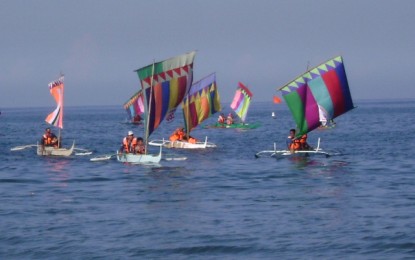
ZAMBOANGA CITY -- The Regatta de Zamboanga is the biggest and the most colorful event in the annual Zamboanga Hermosa Festival.
It is celebrated by native Zamboangueños in honor of their patron saint, the La Virgen Nuestra Señora del Pilar de Zarragosa.
The festival is conducted throughout the month of October. The main events, however, take place during the first 12 days of the month, climaxing on Oct. 12, which is the feast day of the revered “patrona”.
Zamboangueño communities, wherever they are in the Philippines, also celebrate the day.
The regatta is a fluvial racing contest. This year, it took place on Sunday (Oct. 7), as a feature of the Hermosa Festival for years and years now.
The colorful and beautiful sails of the participating vintas exemplify what “hermosa” is, which means “beautiful” in both Spanish and the local creole language of Chavacano.
The official seal of the city includes a vinta image.
This year, some 220 vintas (or bancas) joined the race. Only Zamboanga residents can join the competition, and practically all of them are Badjao and Sama fishermen who reside along the city’s long coastlines, in barangays like Sinunuc, Maasin, Labuan, Mariki, the touristic island of Sta. Cruz, and many other villages.



Each vinta carries two persons, who can paddle to add speed to the wind behind their sail. They follow a marked out course of about 400 meters distance.
The regatta is held off Cawa-Cawa Boulevard (officially renamed R.T. Lim Boulevard some years ago). The kilometer-long coastline is curving, well it was before and during the Spanish regime a settlement of the Badjaos, also known as sea gypsies, when they are not riding the sensual, silver waves of Sulu Archipelago. The tidal currents off the city are strong, though gentle, throughout the day.
One of the participants of the race was Kuntal Bunting, 26, a resident of nearby Barangay Sinunuc.
He is a hook-and-line fisherman, and owns a pumpboat that he rode in the regatta sans its engine.
He goes out to fish three to four times a week, where he would usually haul only five kilos of assorted species that he would sell in the public market.
Another participant was Gapor Jaman, also a Badjao, whose father, Aman, skippered their little wooden banca, only their second year to join regatta.
Gapor said all participants, like him, made their own sails, with the city government giving each of them PHP1,000 for their expenses.
The sails had exquisite and colorful designs. Thousands came to ogle at them from the rim of the boulevard, more than to watch the race. The race is in hits composed of batches of the bancas.
This year, the overall champion was a man named Ladja, also from Sinunuc. He received PHP15,000; the runners-ups collected prizes in descending order of PHP12,000, PHP10,000, PHP7,000, and PHP5,000. All of the participants also received food packages.
The city and its Christian, Muslim and Lumad residents, since time immemorial, live closely with and by the sea.
The Samas’ ancestors provided the workforce to the Spaniards to build Fort Pilar, whose eastern wall bears the embossed image of Nuestra Señora del Pilar.
The fort is made of corals, and the Samas dived down to the nearby seabed to quarry up the rocks.
A “guardia civil” officer built the shrine after, as old legend has it, where one of his guards stopped a woman walking along the fort’s rampart.
“Who goes?” the guard shouted. The woman turned and said, “Don’t you recognize me? I am the Blessed Virgin Mary.”
Years later, the patron saint is credited for saving the city from a tsunami caused by a giant storm, where she was seen walking on the waves to calm them.
Fort Pilar was built by the Spaniards to intercept Moro pirates coming from Sulu in their raiding sorties to Luzon and Visayas, as they pass through the Basilan Strait. Huge cannons fired at the trespassers.
Today, the fort and its venerated shrine continue to provide a sense of security, even impregnability, to its residents -- both Christians and native Muslims. (PNA)
